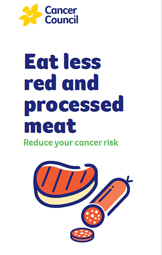- Home
- Cancer Prevention
- Diet and exercise
- Food and nutrition
- Red and processed meat
Red and processed meat and cancer risk
There is strong evidence that eating red and processed meat increases the risk of bowel cancer. Bowel cancer is one of the most common cancers in Australia.
Red meat includes beef, lamb, pork, veal, goat, venison and kangaroo.
Processed meat is meat that has been preserved by smoking, curing, salting or by adding the preservatives nitrates and nitrites. This includes ham, bacon, salami, frankfurt, prosciutto and some sausages such as cabanossi and kransky.
By reducing your intake of red meat and avoiding processed meat you can reduce your risk of cancer.
Meat and cancer risk
Researchers are still investigating how red and processed meat cause cancer. However, there are several possible reasons:
- Red and processed meat contain haem iron, which makes meat red in colour. When haem is broken down in the gut it forms N-nitroso compounds. These can damage the cells lining the bowel, which can lead to cancer.
- The preservatives nitrates and nitrites used in processed meats are also broken down into N-nitroso compounds.
- Cancer causing chemicals develop when meat is burnt or charred. Use lower temperatures to avoid burning and charring.
How much meat should you eat?
Lean red meat is a good source of iron, zinc, Vitamin B12 and protein. You don’t need to stop eating red meat, however, it is best to avoid processed meat, cut down the amount of red meat you eat, and include more plant foods such as fruit, vegetables and wholegrains.
Cancer Council NSW and the Australian Dietary Guidelines recommend that you eat no more than 700 g raw or 455 g cooked, lean red meat each week and that you eat little, if any, processed meat.
A serve of red meat is equal to 90–100 g raw or 65 g cooked:
- ½ cup lean raw mince
- 1 lamb loin chop
- ½ cup diced raw meat
This means, you could have a serve of red meat every day or 2 serves across 3–4 meals a week.
When shopping for red meat, you can use the raw meat guidelines to work out how much to buy. For a family of four buy 400g of lean meat for one meal.
You don’t have to eat red meat. You can get adequate amounts of the nutrients you need from careful food selection.
Try swapping a serve of red meat for:
- 80 g cooked chicken (100 g raw)
- 100 g cooked fish fillet (115 g raw) or 1 small can of fish (95 g)
- 2 large eggs (120 g)
- 150 g (1 cup) cooked or canned legumes, e. g. kidney beans, chickpeas or lentils
- 170 g tofu
- 30 g nuts, seeds, or nut or seed pastes
How to eat less red and processed meat
- Try eating tofu, legumes, nuts , poultry, fish or eggs instead of red meat
- Reduce your serve of red meat and fill at least half your dinner plate with a variety of different coloured vegetables.
- Use more vegetables and legumes in recipes, e. g. add carrot, celery, mushrooms, peas and lentils to bolognaise sauce and chickpeas to curries.
- Eat a meat-free meal at least once every week. Try a vegetable-based pasta, risotto, frittata, soup or curry.
- Use fish or chicken in curries, casseroles, pastas, salads and sandwiches.
- Replace processed meat such as ham, bacon, prosciutto or pepperoni with chicken, tinned tuna, mushrooms, eggplant, tomato, capsicum, baked beans or cheese. Add extra flavour with smoked paprika or chilli. Try this easy vegetable pizza.
- Look at the ingredients list and avoid meat that contains nitrates or nitrites (additives 249, 250, 251 or 252).
Key resource

Eat less red and processed meat
Reduce your cancer risk by eating less red and processed meat.
Download PDF231kB